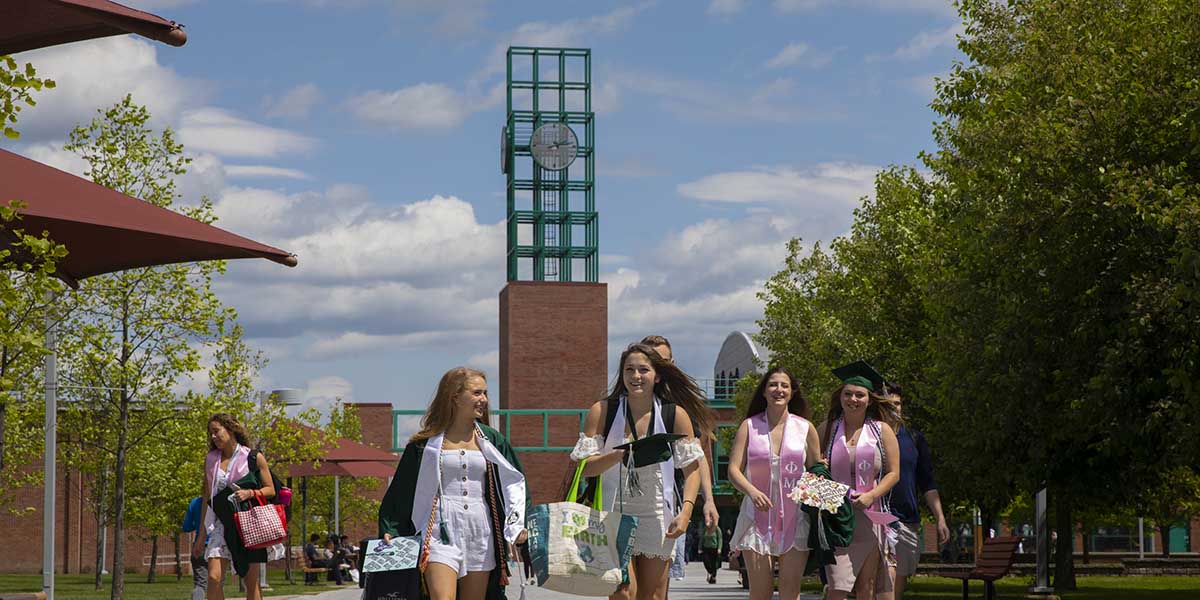Road Map to Premier Update, summer 2021

Nearly 60 members of six Road Map Re-aiming Strategic Priority Committees came together over Zoom at the end of June to review their goals and present updated metrics that will help guide Binghamton University over the next five years.
The re-aiming is the third phase of the Road Map to Premier Strategic Plan that launched in 2013 under President Harvey Stenger’s leadership. The Road Map Renewal in 2017 focused on four University initiatives. Now, the re-aiming process has reorganized the University’s five strategic priorities into six, adding Internationalization to acknowledge the critical importance of supporting, promoting and enhancing strategic internationalization efforts through high-impact learning, teaching, research and engagement.
Representatives from Strategic Priority 1 (SP 1), which focuses on engagement in path-breaking graduate education, research, scholarship and creative activities that shape the world, will present new metrics when the Road Map Re-aiming committees meet in the September, according to co-chair Howard Brown, professor of history. Most of the SP 1 goals will remain the same, he said, but some will be added or revised, along with new metrics, after two new hires are brought on board to help develop them.
“The first hire is for a videographer/website person and the second person will join us as a faculty award coordinator,” Brown said. Both positions were developed to help raise the University’s faculty profile. “None of our current goals and metrics will be abandoned, but we feel they are too narrow and we’ll expand on them.”
Strategic Priority 6 (SP 6), the new committee focused on internationalization, will also present at a future meeting.
Strategic Priorities 2, 3, 4 and 5 presented the following at the June 24 meeting:
- Strategic Priority 2 (SP 2): Provide a transformative learning community that prepares students for advanced education, careers and purposeful living.
The SP 2 committee will keep its goals and will raise some of its metric targets, but some are hard to move, said co-chair Brian Rose, vice president for student affairs. “Metrics inform us and are a measure of our success with students and, for example, retention had a numerical target that we came close to or just reached,” he said. “But these are hard lines to move with a lot of effort for little change, so we set fairly flat targets.
“We also talked about benchmarking our performance against peer institutions, so should we use a comparative benchmark or a flat number?” he asked as an open question to the group. It was suggested that both be used, and that would serve a number of purposes, such as for marketing us as a school where students graduate in four, not six years, keeping their costs lower over four years than they would be at a school with discounted tuition but poor four-year graduation rates.
- Strategic Priority 3 (SP 3): Unite to foster a diverse and inclusive campus culture.
The SP 3 committee readjusted its charge to include the word excellence, basing it on an Inclusive Excellence Model of diversity, equity, inclusion and belonging said co-chair Karen Jones, vice president for diversity, equity and inclusion.
“Essentially, the model looks at diversity as a key component of a comprehensive strategy for achieving institutional excellence – which includes, but is not limited to, the academic excellence of all students in attendance and concerted efforts to educate all students to be successful in a diverse society and equip them with sophisticated intercultural skills,” she said. “We have re-bucketed our goals to represent the Inclusive Excellence Model.”
The group suggested some new targets that are achievable but with sights set high. “In fact, most of our objectives tie to the Truth and Reconciliation Committee recommendations,” added co-chair Daryl Santos, professor of systems science and industrial engineering and vice provost for diversity and inclusiveness. “I think we’ve assessed and made ties to at least eight of the 10 recommendations.”
- Strategic Priority 4 (SP 4): Enhance the University’s economic, social and cultural impact through engagement from the local to the global level.
The establishment of the new SP 6 for Internationalization, removing internationalization from SP 4, allowed the SP4 committee to recalibrate its goals and metrics quite a bit to help create changes that are mutually beneficial to the school and the community, noted co-chair Kelli Smith, assistant vice president for student success.
“There are some big jumps in the metrics for Goal 1 and we really believe that the ability to increase our stipends as an incentive will help us with the number of community engaged learning designated courses,” she said.
For other goals, Smith explained that the committee wants to exceed the national average for student voting, increase its ability to gather data on volunteerism by faculty and staff, and conduct a survey of the community about the extent of engagement with the University.
“We are trying to use Carnegie-level language, even though this isn’t specifically for Carnegie,” Smith said. A new Goal 5 to assess how alumni are engaged with their communities is still in development.
- Strategic Priority 5 (SP 5): Optimize the acquisition and allocation of human, technological, financial and physical resources.
SP 5 will keep all of its current metrics with some minor adjustments of targets, but add three more, said co-chair John Cordi, CFO and senior associate vice president.
“The three new metrics are around how to measure private support in three areas — alumni, annual fund giving and our endowment,” Cordi said. “The third metric is more important to the campus because of what we can utilize for the campus. We’re on a good trajectory and know we will continue to grow the endowment. We want to get to having $25 million available to the campus to use.”
